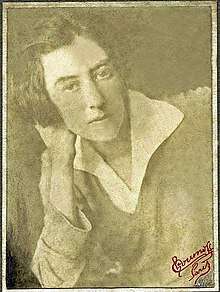Elizabeth Parrish Starr
Elizabeth Parrish Starr (April 29, 1889 – 1943) was an American heiress who volunteered in Europe during both World War I and World War II, dying from starvation at the end of the second.

Biography
Elizabeth (Elisabeth) Parrish Starr was born in April 29, 1889, at 1504 Walnut Avenue, Philadelphia[1] (later the family moved to 1818 South Rittenhouse Square, Philadelphia),[2] the daughter of Louis Starr (1849-1925), a doctor, one of the first to establish paediatrics as a branch[3] and son of Isaac Starr, a banker,[1] and Mary Parrish (1855-1928), a member of the Pennsylvania Society of the Colonial Dames of America.[4][5][6] Starr was the cousin of Dillwyn Parrish, the American writer, illustrator, and painter.
In 1907 she attended schools in Europe.[7] In 1909 Starr became engaged with Stewart Robinson, the nephew of President Theodore Roosevelt and an Harvard fellow student to Starr's brother Dillwyn. Soon afterward, Robinson died in a strange accident, falling dawn from a window dorm.[1]
In 1914 Starr's brother, Lieutenant Dillwyn Parrish Starr (1884-1916), joined the British Army as an officer in the 2nd Coldstream Guards. Starr joined the United States voluntary aid programme in Europe as a Volunteer Nurse and member of the French War Emergency Fund.[1] In 1916, Dillwyn Starr died during the Battle of the Somme.[4] Starr, Head of Reconstruction of the Civilian Section of the Somme region, was decorated by the French government with a Silver Medal, the Médaille de la Reconnaissance Francaise.[1]
In 1921 Starr bought a castle that was actually an old country house, Castello San Peyre, at Opio.[1] In 1934 she became friends with Winifred Fortescue, a British writer and actress, who would in the end move to Opio to live with Starr.[1] Starr is Mademoiselle in Fortescue's books. They spent several years in Provence, and they made friends with an array of personalities: poet John Betjeman; nobleman and aesthete Edward Sackville-West; and Starr's unrequited love, Lady Caroline Paget, immortalized in the painting by Rex Whistler.[1]
At the beginning of World War II, Starr founded the Foyers des Soldats de France. Later Fortescue went back to England, to avoid the war, and gave lectures to raise funds to support France.[1]
Starr remained in France, at Castello San Peyre. She gave shelter to children, and provided what help she could. Towards the end of 1942 food was scarce and Starr became ill. She probably died at the beginning of 1943 from anaemia and malnutrition.[1]
Starr is buried in the little cemetery at Opio, where 8 years later her loyal friend Winifred Fortescue asked to be buried as well.[1]
Legacy
Winifred Fortescue founded The Elisabeth Starr Memorial Fund for the Children of Provence in her honour.[1]
Escape to Provence by Maureen Emerson is the story of Elisabeth Parish Starr & Winifred (Peggy) Fortescue.[1]
References
- "Escape to Provence by Maureen Emerson". maureenemerson. Retrieved 8 January 2018.
- "13 Dec 1907, Fri • Page 8". The Philadelphia Inquirer: 8. 1907. Retrieved 8 January 2018.
- texts Transactions of the College of Physicians of Philadelphia. College of Physicians of Philadelphia. 1926. Retrieved 8 January 2018.
- "Lieut Dillwyn Parrish STARR 2nd Coldstream Guards" (PDF). greatwarbritishofficers. Retrieved 8 January 2018.
- "Mary Parrish". laurenandtristan. Retrieved 8 January 2018.
- Browning, Charles H. (1911). Americans of Royal Descent: Collection of Genealogies Showing the Lineal Descent from Kings of Some American Families ... Genealogical Publishing Com. p. 191. Retrieved 8 January 2018.
- "03 Mar 1907, Sun • Page 43". The Philadelphia Inquirer: 43. 1907. Retrieved 8 January 2018.